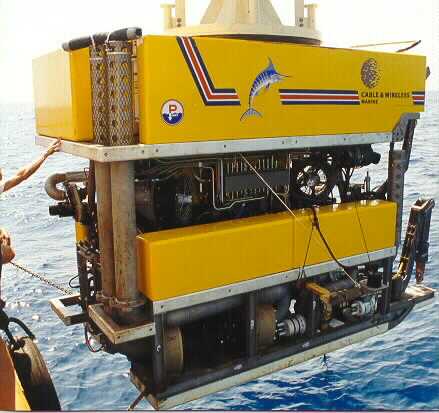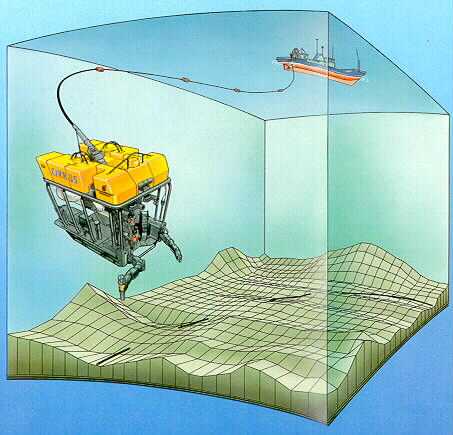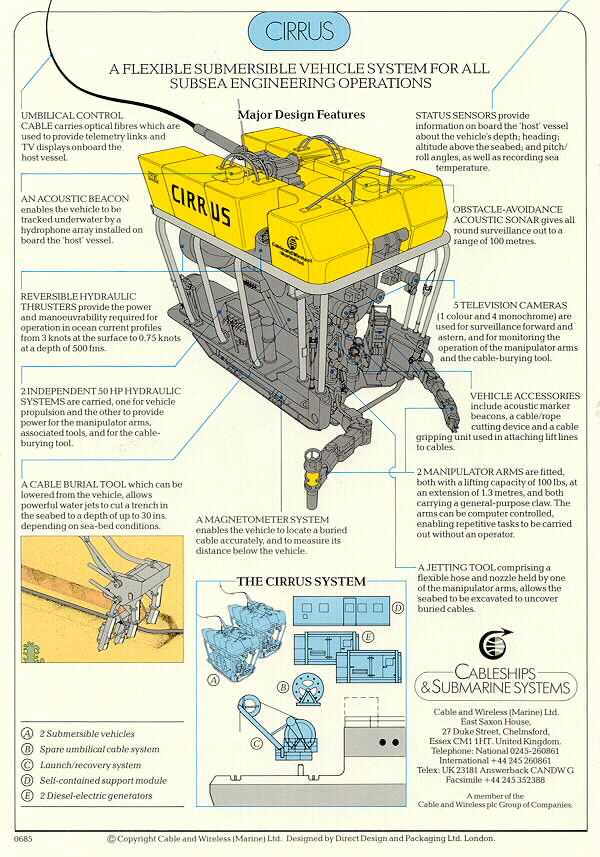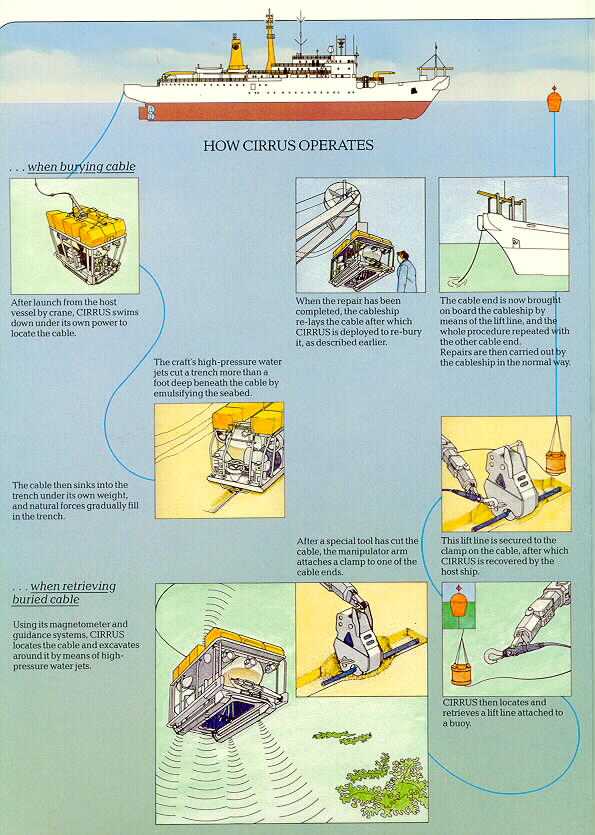
 |
|
|
(Copyright © Global Marine Services Ltd - GMSL.)

Above: GMSL Marlin ROV
The vulnerability of submarine cables to underwater hazards has always been a major concern. Expert route planning can do much to reduce the threat from natural phenomena such as volcanic activity or strong undersea currents. But experience has shown that humans are the major threat to system reliability; fishing trawlers in particular have posed a constant problem, most of all in the shallows of the continental shelf. Over the years, the risk has, to some extent, been reduced by skilful route selection and by suitable armouring of the cable.
Today, cables are often buried to provide even greater protection. The burial operation, particularly when shore-ends are involved, can sometimes be carried out by divers, but below practicable diving depths, the solution is to use either a cableship-towed plough at the time of laying or a free-swimming submersible after the cable has been laid. In the event of a fault in a buried cable, it is impracticable to recover it by conventional cableship grappling operations.
Having in the past used diver-based methods, Global Marine Services Limited (GMSL - formerly Cable & Wireless Global Marine CWGM) is now concentrating on the use of special techniques based upon remotely-controlled submersibles. This new approach is proving very successful. Our submersibles have a proven capability to bury cable at or after installation, disinter it for repair and re-bury it afterwards. With some 5 years experience of operating submersibles in this specialised role, GMSL is in the very forefront of the field. As a member of an international consortium of Owners from Britain, Canada, France and the USA, Cable and Wireless played a major role in the successful conception and development of SCARAB (Submersible Craft Assisting Repair and Burial) which we are responsible for operating.
SCARAB's entry
into service in 1980 added a new dimension to the
business of laying and maintaining submarine cables, and
opened up great possibilities for other applica- tions,
such as seabed survey and the inspection/maintenance of
all types of submerged structures. In the field of deep
sea salvage, our skill as an operator of submersibles was
evident recently when GMSL deployed SCARAB to
pinpoint and successfully recover aircraft flight
recorders and wreckage lying on the Atlantic ocean floor
in some 2000 metres (1¼ miles) of water.

Above: GMSL SCARAB III ROV
Complex manipulative tasks can be carried out by the TAT 9 master/slave manipulator on board. A tool rack is provided at the front of the vehicle, within reach of both the manipulator arms. The air-transportable system package comprises two submersible vehicles, an umbilical cable system for vehicle control, a launch/recovery system and a self-contained support module which includes two diesel-electric generators providing 'dedicated' on-stream and standby power sources at all times. Duplicated instrumentation in the control cabin allows underwater operations and on deck vehicle maintenance to go on simultaneously.
Together with a full inventory of spares and test equipment, housed in an air-conditioned facility, this ensures that the system can be kept fully operational throughout a deployment at sea. The use of optical fibres for vehicle control and data handling links through the umbilical, gives studio-quality TV displays for the Pilot and Co-Pilot in the control cabin on board the host vessel, and ensures ample spare capacity for any specialised equipment which might need to be carried for particular missions. A video recorder enables detailed records of underwater operations to be kept, including a continuous, permanent record of buried cable depth.

CIRRUS ROV
Built to a tough specification for work on submarine cables in deep water anywhere in the world, CIRRUS (Cable Installation, Recovery and Repair Underwater Submersible) offers a combination of design features and operating performance which is exceptional among contemporary submersible vehicles. Its outstanding all- round capabilities provide a power- ful, versatile new tool for all types of offshore operations. These capabilities will be of increasing value as the scope of offshore activity steadily expands into deeper waters and more difficult underwater conditions. The high, 'dedicated' power available for propulsion gives CIRRUS an unrivalled free-swimming ability, which in turn allows the vehicle to operate over a large seabed footprint. In addition, high-precision controls enable CIRRUS to maintain position with the degree of accuracy required for grid surveys and similar missions. Tasks can be carried out without difficulty on sea-bottom slopes up to 30 degrees from the horizontal.
The power pack is duplicated, providing propulsion and the drive for the two manipulator arms, with sufficient spare capacity to power 'special-to-mission' equipment such as, for example, the Jetting Tool used for uncovering buried cables. The use of fibre optic umbilical ensures that ample spare control and data handling capacity is available for such units as side-scanning radar for survey work or detectors for locating oil or gas pipelines. Computer-controlled, the two manipulator arms, each able to reproduce the full range of functions of the human counterpart, can carry out very complex manipulative tasks with great precision, and when necessary, repeat them over and over again without loss of accuracy.
A unique feature of the CIRRUS system package is the back-up vehicle. The provision of this second submersible and completely separate instrumentation for maintenance purposes in the Pilot's Control Cabin, allows one vehicle to be serviced whilst the other is actually operating. An exceptional level of system reliability can therefore be achieved, particularly during long projects. CIRRUS is available to other organisations either as a system package for operation from the customer's own 'mothership' or under turnkey arrangements, with Cable and Wireless also providing and operating the host vessel. In both cases, CIRRUS is entirely operated and maintained by GMSL marine staff, all of whom have considerable, world-wide seagoing experience.


Send mail to Ron Beckett with questions or comments about this web site.
Last Modified: 19-09-2000
© Telstra Corporation Limited 2000
® Registered Trademark of Telstra Corporation Limited.